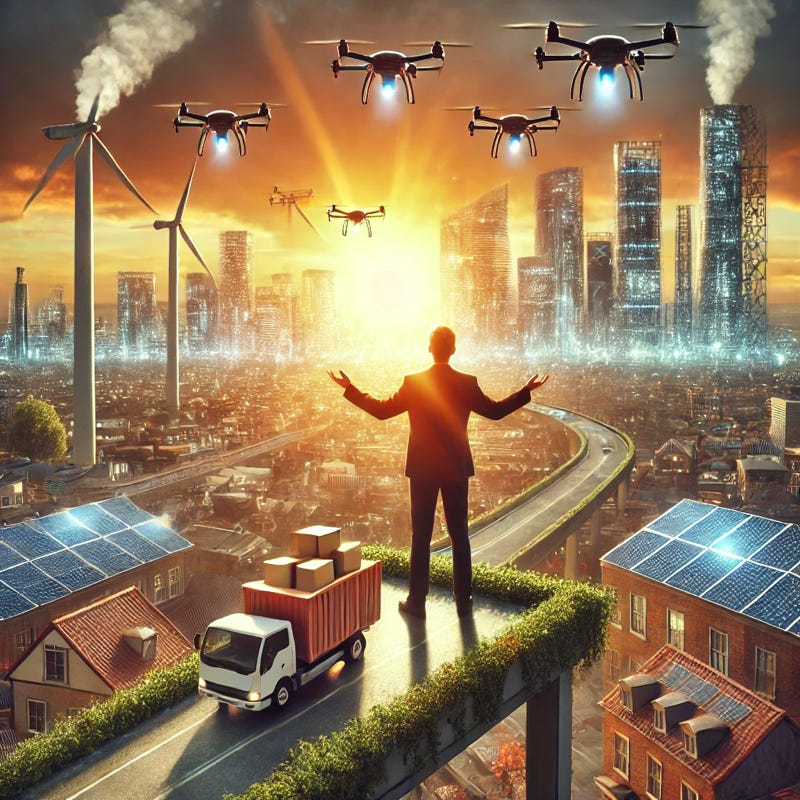1. Introduction
Societies often shift dramatically when pre-existing social and political arrangements can no longer accommodate technological advances and changing values. We live in such a time. Against a backdrop of political polarization and rapid technological breakthroughs, scholars, investors, and futurists alike argue we are on the threshold of profound upheaval—one that will reshape not only our economies, but the very essence of how we govern and who leads us.
George Friedman, a geopolitical forecaster and founder of the intelligence platform Stratfor, provides a structured way to understand these transformative periods by pointing to two overlapping cycles in U.S. history. Meanwhile, entrepreneurial voices such as Tony Seba and Cathie Wood forecast multiple disruptive technologies converging within the next decade. Taken together, these dual pressures—cyclical realignment and technological revolution—signal the dawn of a new era of leadership
.
2. George Friedman’s Two Cycles
George Friedman’s works, notably The Next 100 Years (2009) and The Storm Before the Calm (2020), detail two primary cycles shaping American society:
1. The Socio-Economic Cycle (circa 50 years)
About every half-century, the U.S. experiences structural economic shifts that redefine job markets, core industries, and class relations. Post-World War II manufacturing gave way in the 1970s–80s to a services- and finance-oriented economy, and we now stand at the edge of another reinvention in the 2020s–2030s.
2. The Institutional/Political Cycle (circa 80 years)
Roughly every four generations (near 80 years), the distribution of power among federal, state, and local authorities—and within the three federal branches—undergoes a major reconfiguration. From the Civil War era to the WWII era to today, we see repetitive patterns of crisis and subsequent political recalibration.
Friedman contends that when these two cycles converge—around the mid-late 2020s—they trigger heightened instability as old frameworks no longer fit the emerging social, economic, and technological realities. However, this instability also gives rise to new forms of leadership capable of uniting a fractious society under a fresh ethos and vision.
3. A Golden Age of Converging Technologies
While Friedman’s cycles address structural realignments, they also intersect with disruptive innovations whose pace has accelerated in recent years. Analysts such as Tony Seba and Cathie Wood offer compelling evidence that multiple technologies are poised to revolutionize how we live and work—simultaneously.
3.1 Tony Seba’s Forecasts
In his book Clean Disruption of Energy and Transportation, Tony Seba highlights four pivotal transformations:
Solar & Batteries: Rapidly declining costs of solar panels and battery storage are challenging the dominance of centralized, fossil-fuel-based grids.
Autonomous Electric Vehicles: Cars with fewer mechanical components and driverless capabilities could upend transportation, logistics, and even urban planning.
Precision Fermentation & Synthetic Biology: Lab-grown proteins may replace traditional livestock and reduce environmental impact, similar to how the internal combustion engine once displaced horses.
Artificial Intelligence: AI systems promise efficiency boosts, from managing power grids to automating factories, but they also raise concerns about workforce displacement.
Seba argues that these disruptions typically reach a tipping point faster than legacy institutions expect. By the early 2030s, entire industries could be remade.
3.2 Cathie Wood and ARK Invest
Cathie Wood’s ARK Invest extends the notion of convergent disruption. In its Big Ideas research reports, ARK identifies multiple innovation platforms on exponential growth trajectories, including:
AI & Robotics: Innovations in robotics and machine learning could revolutionize sectors like healthcare, retail, and manufacturing.
Genomics: Advances in gene editing and DNA sequencing may dramatically improve healthcare outcomes and usher in personalized medicine.
Blockchain: Decentralized networks promise to transform finance, property rights, and identity management.
Wood and her team emphasize that each technology serves as a force multiplier to the others, hastening the overall rate of disruption. The confluence of these forces—along with the systemic shifts Friedman observes—may herald a decade of unprecedented change.
4. Emerging Leadership and Society
If these cycles and technological waves converge in the mid-late 2020s, a fresh style of leadership may crystallize. Historically, the U.S. has demonstrated a capacity to reinvent itself when old systems fail or become irrelevant. Whether triggered by social movements, visionary entrepreneurs, or disruptive presidents, large-scale realignment has often produced a novel governance style.
4.1 Traits of the New Leadership
Visionary Adaptation
Leaders must see potential in emerging technologies, leveraging them to solve societal problems.
Elastic Governance
Policy must rapidly respond to automation-driven job displacement, ensuring broad-based prosperity.
Global Cooperators
Advanced AI, energy transitions, and gene editing demand cross-border collaboration rather than unilateral power grabs.
Radical Experimentation
Unexpected proposals—like buying Greenland or forging unprecedented alliances—signal a willingness to redraw economic and geopolitical boundaries. While controversial, these moves can foreshadow future-shaping initiatives.
It remains to be seen whether such leadership will emerge from figures like Donald Trump, Elon Musk, or successors who harness present turbulence to sculpt a new order. But signs are already evident: space collaborations with private companies, public endorsements of alternative energy, and talk of global AI regulation.
5. A Glimpse into 2035: A Short Story
The morning sky glowed a soft pink over the bay as Ava Cho stepped onto the balcony of her fifth-floor apartment. A gentle hum drifted across the city—not from gasoline engines, but from a fleet of autonomous electric drones delivering groceries to clusters of solar-paneled rooftops. At street level, driverless pods glided in near-silent unison, weaving people to work or school without a single traffic jam.
Ava sipped her lab-grown latte, scanning the day’s headlines on a digital screen embedded in her window. A decade earlier, the notion of precision fermentation replacing dairy was radical. Now, the once-controversial fermentation plants on the outskirts of town were hailed for slashing water and land usage. She saw a segment on the latest White House “Fireside Stream,” where President Ortega—a leader who had inherited the tail end of the 2020s turmoil—announced a new global gene-editing treaty. Public sentiment, once marked by cynicism and rage, seemed surprisingly optimistic.
En route to her job at a biotech startup, Ava boarded an AI-driven shuttle. It cruised through the city, guided by a centralized platform coordinating thousands of vehicles in real time. Peering through the window, she noticed wind-harvesting towers atop newly built skyscrapers. Government incentives had spurred a race to install “green spires,” with tech companies vying to design the most efficient wind and solar arrays.
Ava’s mind wandered to stories her grandmother told: years of abrasive politics, warnings of job losses, an endless barrage of controversies. People used to fear AI would steal their livelihoods. But once these technologies matured, society began reorganizing—universal basic income pilots, skill retraining, new economic models that prized creativity and social entrepreneurship. Even the once-divisive “strongman” leaders of the past were eclipsed by a collaborative ethos; the new wave of leadership combined technological foresight with a moral commitment to shared prosperity.
By the time she arrived at her lab, Ava felt the energy of an economy always in motion, driven by a fusion of new ideas and a government that viewed power as a responsibility to facilitate breakthroughs. The bustling plaza outside her building—alive with robotics demonstrations, virtual-reality entrepreneurs, and zero-waste cafés—reflected a collective pride in having navigated a tumultuous transition. The politics of the 2020s had been messy, but they paved the way for leadership that transformed crisis into opportunity.
6. Conclusion
When George Friedman’s two cycles align with the wave of convergent technologies championed by Tony Seba and Cathie Wood, the result can feel like living through multiple revolutions at once. Socio-economic structures, political institutions, and even cultural norms shift at a dizzying pace. The United States, with its history of resilience and innovation, is likely to spearhead these transformations—though not without the friction and instability that accompanies any seismic change.
The short story of Ava Cho in 2035 illustrates a possible outcome if current tech disruptions and leadership realignment fulfill their potential. It is a future of cleaner energy, efficient transportation, abundant synthetic food sources, and an economy reoriented toward creativity and collective well-being. In this scenario, leaders see themselves not as gatekeepers of old paradigms but as stewards guiding society into uncharted territories—valuing adaptability, transparency, and collaboration above rigid hierarchies or outdated power plays.
Ultimately, the viability of this vision depends on our willingness to embrace new leadership models and ensure emerging technologies serve humanity’s broader good. If done well, the painful transition of the 2020s might be remembered not for its chaos, but for planting the seeds of a future where people, technology, and governance converge into a dynamic and prosperous global society.
Footnotes
Friedman, George. The Next 100 Years: A Forecast for the 21st Century. Doubleday, 2009.
Friedman, George. The Storm Before the Calm: America’s Discord, the Coming Crisis of the 2020s, and the Triumph Beyond. Doubleday, 2020.
Seba, Tony. Clean Disruption of Energy and Transportation: How Silicon Valley Will Make Oil, Nuclear, Natural Gas, Coal, Electric Utilities and Conventional Cars Obsolete by 2030. Tony Seba, 2014.
ARK Invest, Big Ideas 2023. https://ark-invest.com/big-ideas
Landler, Mark. “Trump Eyes a New Real-Estate Purchase: Greenland.” The New York Times, August 15, 2019.
Written as an independent analysis synthesizing publicly available sources.












Share this post